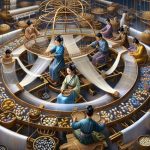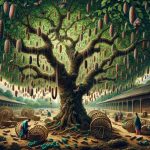Silk, a luxurious fabric, has a deep-rooted history in global trade and cultural exchange. Originating from China over 8,500 years ago, it became a sought-after commodity. The Silk Road connected nations, fostering trade and sharing cultures. Silk's significance extended to clothing, art, and more. Today, China remains a leader in silk production. Japan and other countries also contribute considerably. Despite modern challenges, silk endures as a symbol of elegance and tradition. Its story reflects a journey of discovery and global connections.
Table of Contents
Key Takeaways
- Silk has a history dating back over 8,500 years in China.
- Chinese mastery led to a global monopoly on silk.
- Silk trade routes facilitated global trade and cultural exchange.
- Silk production supports millions worldwide and promotes sustainability.
- Silk is a luxury fabric with enduring economic and cultural significance.
Origins of Silk in China
Silk production in China traces back over 8,500 years to the Neolithic period, marking the origins of this luxurious fabric in world history. The Chinese played a pivotal role in silk production, with the mulberry tree being essential for feeding the silkworms responsible for spinning the silk threads.
Weaving became a skilled craft, transforming the raw silk into intricate and beautiful textiles. What made Chinese silk production unique was the closely guarded secret surrounding sericulture methods. This secrecy allowed China to maintain a monopoly on silk production for centuries, which contributed immensely to the country's economy, particularly during the prosperous Tang Dynasty.
Initially, silk was a symbol of luxury reserved for the emperor and elites, but its popularity grew, and it eventually permeated through various social classes, becoming a staple in Chinese culture and trade. The evolution of silk production in China showcases the nation's innovation and mastery in creating one of the most coveted fabrics in history.
Evolution of Silk Production
I'll outline the shift from ancient silk techniques to the modern silk industry.
I will also highlight key advancements and changes in production methods worldwide.
Ancient Silk Techniques
During the ancient times of silk production, the evolution of techniques for cultivating silk worms and weaving intricate patterns marked a significant advancement in the industry. The quality of silk significantly improved during the Han dynasty as weavers, primarily women, dedicated themselves to caring for the silk worms.
Silk production in ancient China not only provided families with an essential source of income but also played an important role in the region's economic prosperity. The spread of silk production beyond China to regions like Korea, Japan, India, Byzantium, Arabia, Levant, and Italy showcased the global impact of this ancient industry.
Moreover, the state-controlled nature of the Chinese silk industry in Korea and Japan underscored the influence and importance of silk production in various parts of the world.
Modern Silk Industry
Amidst the historical legacy of silk craftsmanship, the modern silk industry has continually evolved, adapting to global shifts and technological advancements to maintain its status as a sought-after luxury material.
Today, countries like China, Japan, South Korea, and Thailand play significant roles in the silk industry, ensuring its prestige in the modern world.
However, post-World War II, challenges arose with the emergence of man-made fibers such as nylon, posing a threat to traditional silk production. Innovations like Louis Pasteur's discovery in 1865, which helped combat a silkworm plague, have been vital in aiding modern sericulture practices.
Japan's advancement in sericulture methods has solidified its position as a leading supplier of raw silk, showcasing the industry's ability to adapt and thrive in the face of changing times.
Silk Trade Routes
Silk trade routes interconnected regions across East Asia, Europe, India, and Africa, facilitating the exchange of goods, with silk emerging as a prominent and coveted commodity along these ancient pathways. The Silk Road, an ancient trade route, played a pivotal role in connecting distant civilizations and fostering global trade. Chinese silk exports were a cornerstone of this network, reaching Korean kingdoms, Japan, India, Persia, Egypt, Greece, and Rome. The Romans even referred to the Chinese as 'Seres' because of their association with silk trade, underscoring the cultural impact of this luxurious fabric in international trade.
For centuries, silk remained a prized Chinese export, maintaining its significance until the 15th century CE. The expansion of silk production beyond China to regions like Korea, Japan, India, Byzantium, Arabia, Levant, and Italy exemplified the widespread demand for silk along these trade routes. This intricate web of commerce not only enriched economies but also facilitated cultural exchange and technological diffusion, shaping the course of history.
Silks Cultural Impact
As the demand for silk expanded along the ancient trade routes, its cultural impact reverberated across diverse societies through its versatile uses and symbolism.
Sericulture reached new heights, allowing for the production of silk on a large scale. The art of silk became intertwined with various aspects of daily life, with silk being used for clothing, hand fans, furnishings, banners, funeral banners, and even Buddhist mandalas.
Brightly colored silk robes, in particular, symbolized social status and wealth in many societies, becoming a marker of prestige. The wearing of silk was often restricted to the upper echelons of society, emphasizing its exclusive and elite status.
Over time, silk embroidery evolved into a refined art form, showcasing intricate craftsmanship and designs that captivated onlookers. Silk not only adorned the body but also found its way into the domains of art and writing, replacing traditional materials like bamboo or paper in certain contexts.
Silk in Asia
Silk in Asia holds a rich history dating back thousands of years, originating in China and later spreading through trade routes like the Silk Road to neighboring regions.
The intricate silk production techniques developed over various Chinese dynasties, showcasing the artistry and skill of weavers.
This luxurious fabric was initially reserved for the elite, symbolizing status and wealth in Asian societies.
Silk Origins in Asia
Originating in ancient China around 3000 BC, silk production holds a significant place in Asian history. The ancient Chinese skillfully cultivated silkworms of the Bombyx mori species through the practice of sericulture. This meticulous process involved the careful breeding and feeding of silkworms to produce fine silk fibers.
China's mastery of silk production allowed it to establish a virtual monopoly on this valuable commodity, which was highly sought after for its luxurious qualities. As Chinese silk gained popularity, it became a pivotal element in trade, both within Asia and beyond. The allure of silk spread to neighboring regions like Korea and India, challenging China's initial dominance and contributing to the widespread influence of this ancient craft.
Silk Trade Routes
Establishing vital connections between East Asia, Europe, India, and Africa, silk trade routes served as conduits for the exchange of goods and ideas. Chinese silk exports were at the heart of this intricate network, reaching Korean kingdoms, Japan, India, Persia, Egypt, Greece, and Rome.
The Silk Road, a prominent trade route, allowed for the economic significance of silk to flourish, with Chinese silk export dominance lasting until the 15th century CE. This extensive trade not only boosted economies but also fostered cultural exchange, spreading silk production techniques beyond China to various regions.
The Silk Road's legacy lies not only in the silk trade but also in the lasting impact it had on global commerce and cultural interactions.
Silk Production Techniques
Evolutionary over millennia, the art of silk production in Asia traces its roots back to ancient China around 3600 BCE. Ancient Chinese silk weavers utilized sophisticated drawlooms and pedal looms to create intricate designs, elevating the quality of silk.
Sericulture, the practice of cultivating silkworms, was a closely guarded secret in ancient China, contributing to the exclusivity of silk production. Over time, these silk production techniques spread to various regions in Asia, including Korea, Japan, and India.
Advancements in sericulture and weaving methods further refined the quality of silk, cementing its reputation as a prized commodity. The evolution of silk production techniques in Asia showcases the mastery and innovation that have characterized this ancient industry.
Silk in Europe
During the 1st century BC, silk trade with Europe via the Silk Road began, influencing Roman fashion and economy. The allure of Chinese silk captivated Greeks and Romans by the 4th century BC, leading to its widespread adoption in Rome.
Silk became a symbol of status in Roman society, with Emperor Heliogabalus famously wearing silk exclusively. By the 6th century, the Byzantine Empire had established a monopoly on silk production, which had a significant impact on the market for Chinese silk in Europe.
Italy joined the silk production scene in the 13th century, attracting skilled weavers from Constantinople and further diversifying the European silk industry. The journey of silk through Europe showcases not only the material's luxurious appeal but also its ability to shape the fashion trends and economies of the regions it touched.
Silk in the Middle East
Silk in the Middle East has a rich history. The Byzantine Empire played an important role in introducing silk production to the region in the 6th century AD. The Byzantines imported silkworms from Central Asia, leading to the establishment of high-quality silk weaving known for its intricate designs.
This mastery of silk weaving extended to the Persians by the 6th century, further enhancing the economic and cultural significance of silk in the Middle East.
Silk Trade Routes
How did Middle Eastern traders contribute to the distribution of Chinese silk to Europe and Africa? Middle Eastern traders played a crucial role in the Silk Road network, acting as intermediaries in bringing luxurious Chinese silk to distant lands. Through their expertise in trade and navigation, they facilitated the flow of silk and other goods, fostering cultural exchanges and economic prosperity along the way. The table below highlights key aspects of the silk trade routes in the Middle East:
| Aspects | Description | Importance |
|---|---|---|
| Silk Road | Connected China to the Middle East | Essential trade route |
| Middle Eastern Traders | Facilitated distribution of Chinese silk | Key players |
| Cultural Exchanges | Occurred along the silk trade routes | Enriched societies |
| Economic Prosperity | Silk trade routes boosted economies in the region | Wealth generation |
| Luxurious Chinese Silk | Highly coveted in the Middle East | Symbol of status |
Silk Production Techniques
In the domain of silk production techniques, the Middle East played a crucial role as a crossroads for the dissemination and enhancement of sericulture practices. The Byzantine Empire imported silkworms from Central Asia, leading to the establishment of sericulture. Byzantine silk was renowned for its high-quality weaving and intricate decoration.
This region's strategic location on the Silk Road facilitated the exchange of knowledge and techniques, spurring silk production in North Africa and other neighboring areas. The Middle East's influence on silk production techniques extended far beyond its borders, contributing immensely to the growth and refinement of the silk industry in various regions.
Silk Cultural Influence
With its introduction through trade along the Silk Road, silk swiftly embedded itself in the cultural tapestry of the Middle East. The influence of silk in the region was significant, shaping various aspects of society. Some key points to note include:
- The Byzantine Empire imported silkworms from Central Asia to enhance its silk industry.
- Silk weaving in the Byzantine Empire was renowned for high-quality weaving and intricate designs.
- Silk played an important role in the economy and culture of the Middle East, becoming a symbol of luxury and status.
- The trade of silk along the Silk Road facilitated cultural exchange and influenced artistic expressions.
- The spread of sericulture to regions like Andalusia, Sicily, and Southern Italy had a notable impact on the silk industry in the Middle East.
Silk in Modern China
China's dominance in the global silk industry is undeniable, with over 70% of the world's silk production originating from this ancient land. Chinese silk exports became a pillar of the economy, driving growth and prosperity. The industry never ceases to amaze with its modern techniques and innovative approaches to sericulture practices. Sustainability is a key focus, ensuring that the legacy of silk production continues for generations to come.
| Aspects | Description |
|---|---|
| Economic Impact | Silk industry employs millions, making a substantial contribution to China's economic prosperity. |
| Technological Advancements | Modern techniques have enhanced efficiency and quality of silk products in China. |
| Focus on Sustainability | China's silk industry places a strong emphasis on sustainable sericulture practices. |
| Global Dominance | China remains the leader in global silk production, setting the standards for the industry. |
| Innovation in Practices | Constant innovation drives the evolution of sericulture practices in the Chinese silk industry. |
Silk in Modern Japan
Embracing sericulture techniques from ancient China, Japan has cultivated a thriving modern silk industry that upholds a tradition of excellence and innovation. Japanese silk production has a rich history dating back to the 4th century and has played an important role in the global silk trade.
- Rural Communities: Sericulture spread throughout Japan, supporting rural communities and becoming an essential economic activity.
- Silk Weaving Traditions: Japanese silk weaving traditions have evolved over time, with intricate patterns and high-quality silk fabrics becoming renowned.
- Global Silk Trade: Japan became a major raw silk supplier, contributing significantly to the global silk trade.
- High-Quality Silk Fabrics: Modern Japan continues to produce high-quality silk fabrics, maintaining its reputation for excellence.
- Economic Activity: The silk industry remains a crucial economic activity in Japan, supporting livelihoods and contributing to the country's economy.
Silk in Global Industry
The global silk industry remains a significant player, with China and Japan leading as the main silk producers worldwide. Together, they contribute to over 50% of global silk production annually. Despite competition from man-made fibers, world silk production has doubled in the last 30 years.
China significantly increased its silk production in the late 1970s, reclaiming its position as the top silk producer. In modern times, silk continues to be an important industry, with production and trade persisting globally. The silk industry supports over 34 million people worldwide, with countries like China, India, Brazil, North Korea, Thailand, and Vietnam being major silk producers.
This industry's resilience and growth showcase its enduring significance in the global market, where countries compete to maintain their positions as top silk producers.
Silks Continued Significance
Despite the rise of man-made fibers, silk continues to maintain its significance in the global market, supported by its unique properties and essential tradition in craftsmanship. The global significance of silk production is undeniable, with 34 million people worldwide relying on it for economic stability. Countries like China, India, Brazil, North Korea, Thailand, and Vietnam play a vital role in silk production, highlighting its widespread reach.
The preservation of traditional craftsmanship through the passing down of silk weaving skills across generations reinforces silk's cultural importance. In addition to its economic impact, silk farming contributes to local livelihoods in rural communities, promoting sustainability. Silk's reputation as a luxury fabric stems from its unique properties, making it a highly sought-after material known for its quality and elegance.
The enduring appeal of silk in the modern era underscores its irreplaceable position in the textile industry.
The Silkroad Foundations Role
Playing a pivotal role in preserving the history of the Silk Road, the Silkroad Foundation is based in Saratoga, California.
The foundation, active from 1997 to 2000, focuses on promoting silk history and culture, emphasizing the significance of the Silk Road in global trade.
Through its website, the Silkroad Foundation provides valuable resources and information on the history of silk, serving as an educational platform for those interested in learning more about this ancient trade route.
Frequently Asked Questions
What Was Silk Used for in History?
Silk in history served various purposes like clothing, furnishings, and writing material. It symbolized luxury and status, with laws restricting its use to the upper classes. Intricate silk embroidery also became a notable art form.
What Is the History on Silk?
Silk has a rich history originating in China over 8,500 years ago. Initially reserved for the elite, silk spread through the Silk Road to Korea, Japan, and India. Europe later became a major silk producer during the Middle Ages.
What Is the Definition of Silk in Ancient China?
In ancient China, silk was a luxurious fabric made from silkworm cocoons. It symbolized wealth and status, produced through carefully rearing silkworms, harvesting cocoons, and extracting silk threads. Silk was initially exclusive to the imperial family and officials.
What Is Silk and Its Importance?
Silk, a luxurious fabric made from silkworm cocoons, is prized for its softness and sheen. Its significance lies in symbolizing wealth and luxury. Silkworms are nurtured, their silk extracted, and woven into fabric, showcasing its historical importance.
- Where to Buy Sherpa Suede Fabric - July 12, 2025
- How to Draw or Illustrate the Texture of Suede Fabric - July 12, 2025
- What Is Baseball Suede Leather Fabric? - July 12, 2025







